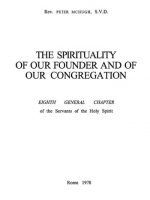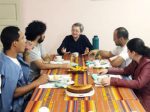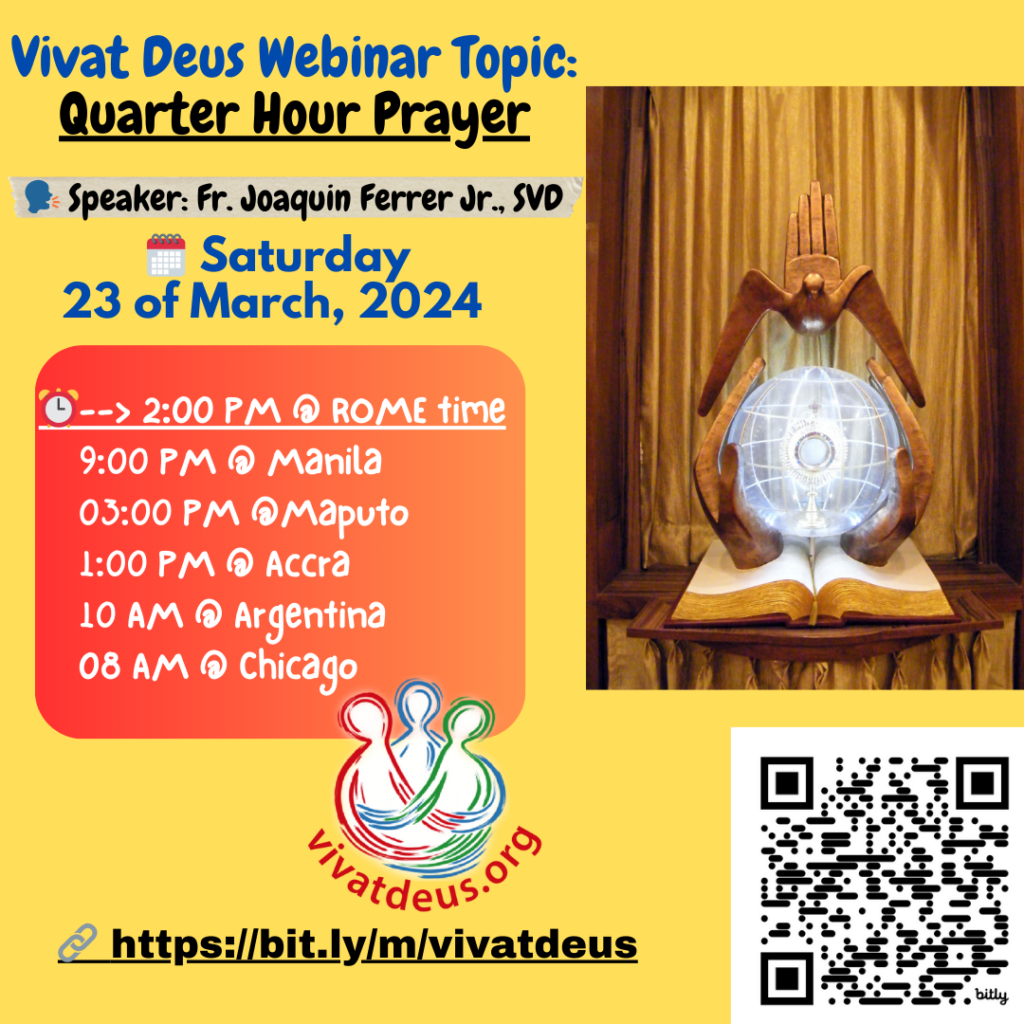On Christmas Day, 25 Dec. 1902, Fr. Arnold Janssen wrote a letter to his blood brothers Gerhard, Peter, and Theodor: We celebrated truly a beautiful Holy Christmas, especially the solemn nightly prayer services and the crib processions, held in all our European houses. At midnight, we set off from the church to the largest hall of the house, where the crib was prepared and surrounded by lights. We carried it in a solemn procession to the Church while praying and singing.
From this simple note, one couldn’t surmise the mystical character of the Founder’s devotion to the Incarnate Word. Nevertheless, the Christmas devotion spread quickly and widely in the Society. This was due to a very peculiar aspect of the Founder’s spiritual experience within the years 1883 to 1909. Only apparently does this fact seem to be in conflict with his sober mathematical and scientific attitude. Fr. Arnold wanted a Congregation of the Divine Word to proclaim the Word of God. So, the Divine Word Himself became the unifying principle of the Society’s spirituality in all its activities and eventually the only reason for its existence. It is always touching to see Fr. Arnold leaning with tender love over the Divine Child, Verbum Caro Factum Est. In this child, he adored the goodness and kindness of God through our Savior, who had appeared to all mankind. In this deeply rooted worship, he took the child tenderly in his arms to speak to Him with childlike love.
What is the genesis and form of this Christmas devotion? What did it mean to Father Arnold and what remains important for our missionary life?
Father Arnold’s biographer, Fr. Hermann Fischer (1919), recounted the Christmas Crib Procession in Steyl conducted by the Founder. The little figure of the Infant Jesus, destined for the crib erected in the church, is placed on straw in the hall of the mission house, surrounded by candles and votive lights. Both the hall and the main corridors of the house are illuminated with Chinese lanterns and decorated with wreaths. At midnight the inhabitants of the house are awakened by a band of the mission Brothers playing Christmas hymns. All hasten to the church and from there march in procession to the hall.[1]
Fr. Grosse-Kappenberg reminisced: With deep emotion and warmth, Father Arnold then recited the prayer he himself had composed. It began with the joyous proclamation of the Christmas mystery; the goodness and kindness of God our Savior has appeared. This was followed by the prayers of salutation, adoration and thanksgiving and many petitions, especially for the sacred work of the missions and for the Holy Church. Then, very like the gray-haired Simeon in the temple, he took the Infant in his arms in a gesture of childlike devotion, blessed the community with it and tenderly placed it on the litter beautifully covered with satin cloth. The Superior General always conducted this ceremony in the mother house by himself (…). He did so for the last time on Christmas 1907. I will never forget the impression the grey-haired priest made as he knelt before the Christ Child and recited the prayers that welled up from his heart, his face radiant with devotion and holy joy. On this occasion he was truly in his proper element. In sincere, childlike, ardent and deeply pious thought[2].
On that prayerful and joyful Holy Night, Father Arnold was full of love and great affection. This impressive procession with the Child Jesus to the crib grew out from our Founder’s soul in a very natural way.
Already in the first year of the foundation, Father Arnold bought a crib for St. Michael Mission House in Steyl from the Sisters in Aachen for 33 Marks. To foster the devotion to the Divine Word, in 1883, he introduced for the first time the crib procession in Steyl. According to Fr. Albert Rohner, the crib procession came into being by transforming the practice to an imploring procession for the intention of the Southern Shandong Mission.[3] Probably, Father Arnold was inspired also by the Franciscan tradition, that is, St. Francis’ love of poverty. The figures of the first crib in St. Michael’s upper church were made of wax. Later, the very valuable crib was sent to the missions but the Child Jesus, acquired from the Sisters of the Poor Child Jesus of Simpelveld, remained in the first crib.[4]
A special rite for the procession was found in the 1899 Vademecum of the Society. Also, in St. Wendel, Fr. Arnold organized the first crib procession and trained the Brothers and students how to perform it well. The Superior of St. Raphael House in Rome, Fr. Hermann Wegener, wrote from the Eternal City to Steyl on 1 January 1899: You have a more beautiful crib in the Upper Church than I have seen in many of the churches in Rome. Interestingly, Fr. Josef Grendel, the rector of St. Gabriel at that time, wanted to discontinue the crib procession, but when he became Superior General, there was no one like him who defended all the traditions of the Society, including the crib procession in the Society.
Not only at Christmas night but throughout Christmas time, Father Arnold worshiped the Divine Nativity. During the evenings and alone in the chapel, he would put out the lights, take the image of the Baby Jesus out of the crib, and he would walk up and down with it in his arms, praying and meditating, as if overwhelmed by love. The ones who saw him were inspired immensely and could not forget what they had witnessed. We read in the first Jubilee history of the Society (1900): Within January takes place almost every day the Crib Service in honor of the Divine Child to beseech the grace of conversion of the poor pagans. [5]
The firm grounding of the Society in the mystery of Incarnation is a precious heritage and task for our Society. In all our undertakings we are to strive for the continuation and completion of the Incarnation in the hearts of all. Fr. Arnold conveyed to us the excellence of our missionary vocation based on the Incarnation, in which the value of our work does not depend on what we do but how we do it. All depends on our interior attitude, readiness and faithfulness, our love and dedication in the missionary service to the Divine Word. The Founder’s love for the Child Jesus wasn’t sentimental but deeply apostolic and missionary.
Fr. Johannes Schütte, at the outset of the Vatican II, highlighted our often-forgotten call to internalize the mystery of the Incarnation as the Socii Verbi Divini: As members of the Society of the Divine Word, are we not bound to foster precisely this interior, intimate familiarity with the eternal Divine Word, to meditate on His eternal wisdom, beauty and lovableness, and to delve ever deeper into the mysteries of the incarnation? Have we any great men of prayer in the Society today? At any rate, they are seldom spoken of (…) If we wish to become worthy of our Name of the divine Logos, the eternal Wisdom, we must make great demands on our spiritual and intellectual achievements. We should not only live and work under His Name, but also be penetrated by His power and example, by the light of His wisdom and truth, by His beauty and love in all our service of preaching Him. It is the Divine Word Who binds together all the varied activities of the Society.6
Fr. Arnold Janssen was fascinated by the mystery of God’s incarnation, by his self-abasing love: What a great and sublime example our Savior gave us at His entrance into this world. He did not choose glory and wealth, as was his due, but contempt and poverty. Let us consider this well when we adore the Divine Savior at the crib and let us engrave his example into our minds so that we can imitate his humility. The mystical experience of the mystery of divine love gave Fr. Arnold Janssen a meaning for his whole life. He understood the great message of the holy night of Christmas that we cannot please God unless we become small. His most treasured desire was that all people would recognize and share this mystery. Like the star, He wanted to shine out and to proclaim God’s love with brilliant rays to the furthest places, into the whole world. Inflamed by God’s Incarnated Love, he wanted to inflame all others with this Love.
“Arnoldus Nota” December 2015, pp. 15-16.
———–
[1] See: the English version of Fischer’s biography Life of Arnold Janssen, translated by Fr. Lynk, Techny 1925, p. 451.
[2] Fr. Grosse-Kappenberg, Remembering, Analecta SVD -42, p, 119-120.
[3] A. Rohner, Die Gebete Arnold Janssens, Analecta SVD-56, Romae 1982, p. 119.
[4] Happily up to this day, the figure of the child Jesus is preserved in the Oratory of St. Michael’s House, transferred there from the memorial Room of St. Gregor House in 2014.
[5] Fr. Hermann auf der Heide, Die Missionsgenossenschaft von Steyl in the Jahren 1875-1900, Steyl 1900, p. 129.








One Response
El último capítulo lanzó un lema – Nuestro nombre es nuestra misión. Resulta interesante ver, cómo a través de la historia de la congregación aparece como un cierto remordimiento de conciencia de que aún no estamos a la altura del nombre que tenemos. En este artículo apracen palabras del general Schutte que dice: “Si queremos ser dignos de nuestro nombre ….”. Y por cierto, eso de ser “mistico de la Encarnación” es de lo más actual en nuestra vida misionera en el siglo presente.